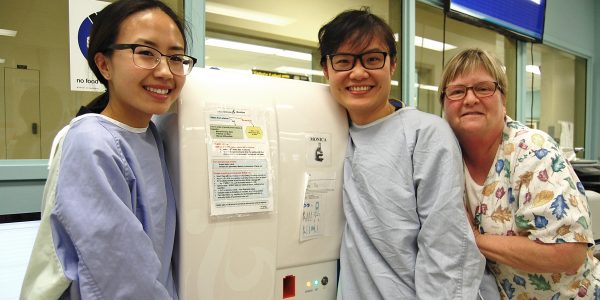Monica tells the story of blood at RH
In her short time in Richmond Hospital’s lab, Monica’s become a much-trusted member of the technology team.
Although colleagues would agree she takes up a little too much space at the bench, she’s given that extra bit elbow room due to her singular focus on getting the job done with impressive accuracy. Monica’s co-workers — and certainly patients who have benefited from her diagnostic prowess — aren’t sure what they did before her arrival less than a year ago.
Meet Monica. She’s a $120,000 state-of-the-art Cellavision unit, purchased for Richmond Hospital by the Richmond Hospital/Health Care Auxiliary. Monica’s job is to read the physical properties of blood. She breaks down each cell into its component parts – red blood cells, white blood cells, platelets and plasma — so that physicians can detect abnormalities and begin work leading toward accurate diagnostic and treatment decisions.
In addition to Richmond Hospital’s lab, Cellavision technology is also in place at VGH, St. Pauls and Surrey Memorial hospitals.
Monica’s named for the former and much-loved lab technologist, Monica Brammer, who previously did the job manually until her retirement several years ago. “Monica (the real one!), was tickled when she heard the news,” said Kathy Biel, Medical Laboratory Technologist. “She was here for a really long time, so this was our way of paying tribute to her.”
The puzzle of blood
Monica works in tandem with new $90,000 slide stainer that was purchased for the lab by the Richmond Hospital Foundation. The new stainer creates high-quality blood smears to produce slides that are easy for Monica to read and analyze with impressive accuracy. Together, the diagnostic tools have resulted in improved patient care at Richmond Hospital.
“Through providing more accurate lab results, we can provide more timely diagnosis and improve a patient’s quality of life,” said Len Perry, manager, Laboratory Operations. “That’s what this is all about.”
Reading the physical properties of blood using a manual microscopy is a laborious and time-consuming procedure. Every blood cell has a story to tell, but deciphering the mix of cell types to understand a person’s health was — in the not-so-distant-past — more art than science. It is a procedure that can be dependent on an individual technologist’s level of experience and expertise.
At Richmond Hospital, however, Monica has leveled this playing field.
“Our lab always gave good results, but now we give excellent results, and at all times,” said Teresa Sharp, chief technologist, Laboratory, VCH Richmond. “Everyone now receives the same standard of care.”

